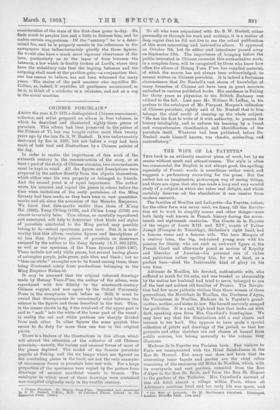CHINESE PORCELAIN.* Anoum the year A.D. 1575 a distinguished Chinese
connoisseur, collector, and artist prepared an album in four volumes, in which he described and illustrated eighty-three pieces of porcelain. This album had been preserved in the palace of the Princes of Yi, but was bought rather more than twenty years ago by the late Dr. S. W. Bushell. It was unfortunately destroyed by fire in 1887, but not before a copy had been made of both text and illustrations by a Chinese painter of the day.
In order to realise the importance of this work of the sixteenth century in the reconstruction of the story, or at least a part of the story, of Chinese ceramics, two circumstances must be kept in mind. All the figures and descriptions were prepared by the author directly from the objects themselves, which either were his own property or belonged to friends. And the second point is of equal importance. The author wrote his account and copied the pieces in colour before the time when imitations of the early porcelains of the Ming dynasty had been made, as they have been in vast quantities, marks and all, since the accession of the Mancha Emperors. We know that date-marks earlier than those of Kang Hsi (1662), Yung Ch'eng (1723), and Mien Lung (1736) are almost invariably false. This album, so carefully reproduced and annotated, will help to determine what kinds and styles of porcelain attributed to the Ming period may possibly belong to it,—aotual specimens prove rare. But it is note- worthy that this album contains figures and descriptions of no less than forty-two pieces of porcelain or stoneware assigned by the author to the Sung dynasty (A.D. 960-1279), as well as one specimen of the Yuan dynasty (1280.1367). These include not only white pieces, but several having glazes of aubergine purple, jade-green, pale blue, and black ; but no " blue-on-white " examples are to be found among them, these being illustrated solely from productions belonging to the Ming Emperor Hstian-te.
It may be assumed that the original coloured drawings
made by Hsiang Yuan-P'ien, the author of the album, were reproduced with fair fidelity by the nineteenth-century Chinese copyist, and now again by the Oxford University Press in the sumptuous book before us. Still, it must be owned that discrepancies do occasionally exist between the colours in the figures and those described in the text; Thus, in the censer shown in fig. 8 the coral-red of the upper part is said to " melt" into the white of the lower part of the vessel ; in reality the red and white portions are sharply divided from each other. In other figures the same greyish blue seems to do duty for more than one hue in the original pieces.
There is a feature of the illustrations in this album whieh
will attract the attention of the collector of old Chinese porcelain,—namely, the variety and unusual forms of most of the pieces depicted. The model of the famous porcelain pagoda at Peking, and the six lamps which are figured on the concluding plates in the book, are not the only examples of uncommon forms in porcelain here met with. For a large proportion of the specimens were copied by the potters from drawings of ancient sacrificial vessels in bronze. The catalogue in which most of these drawings were contained was compiled originally early in the twelfth century.
• Chincao Porcolain, By Hsiang Yawl. Plea. Translated and Annotated by 8, W. Bushell, C.M,O., M.D. 83 Coloured Plates. Oxford : at the Clarendon Press, [1055.] To all who were acquainted with Dr. S. W. Bushell, either personally or through his work and writings, it is a matter of deep regret that he did not live to see the actual .publication-. of this most interesting and instructive album. It appeared on October 7th, but its editor and introducer passed away on September 19th. The importance of bringing before the public, interested in Chinese ceramics this authoritative work,. in a complete form, will be recoguiaed by those who know how often the album of Hsiang Yuan P'ien has supplied material, of which the source has not always been acknowledged, to several writers on Chinese porcelain. It is indeed a fortunate circumstance that Dr. Bushell's vast stores of knowledge of many branches of Chinese art have been in great measure embodied in various published books. His residence in Peking for thirty years as physician to the British Embassy was utilised to the full. Last year Mr. William H. Laffan, in his preface to the catalogue of Mr. Pierpont Morgan's collection. of Chinese porcelain, rightly said of Dr. Bushell that to him belongs the chief credit of clearing up the whole subject.
He was the first to write of it with authority, to present its history intelligibly, and to enforce his learning by a broad and comprehensive classification and identification of the porcelain itself. Whatever had been published, before Dr. Bushell made himself known, was chaotic, misleading, and contradictory."














































 Previous page
Previous page